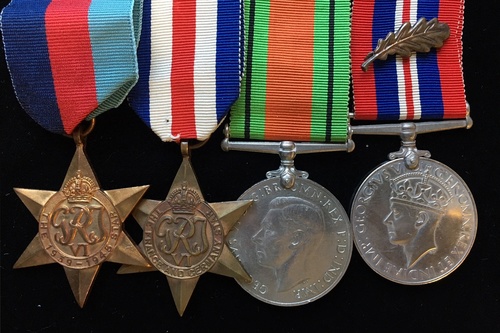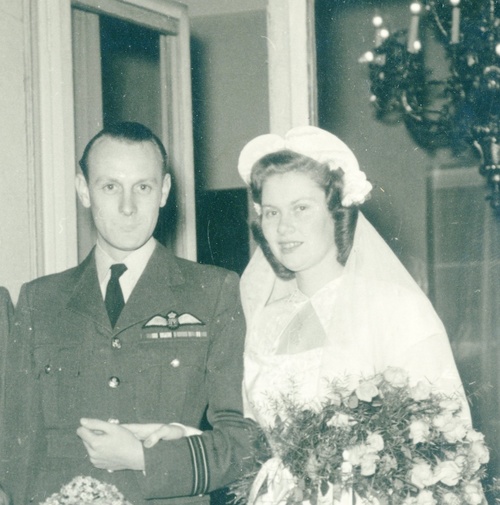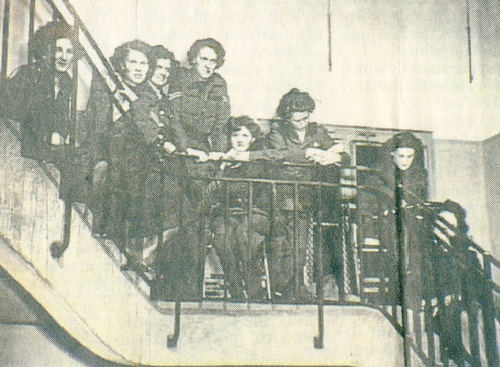Auction: 17003 - Orders, Decorations and Medals
Lot: 600
Family group:
The Second World War campaign group of four awarded to Flight Lieutenant W. B. Hibbert, Royal Air Force, who completed a remarkable tally of 70 "Circus" and "Ramrod" sorties in Bostons and Mitchells of No. 226 Squadron, among them Operation "Oyster", the spectacular strike on the Philips factory at Eindhoven
1939-45 Star; Air Crew Europe Star, clasp, France and Germany; Defence and War Medals 1939-45, together with the recipient's embroidered uniform 'Wings', good very fine
The Second World War campaign group of four awarded to Staff Sergeant S. N. Hibbert, Auxiliary Territorial Service, who was attached to Eisenhower's staff and - amidst great secrecy - typed up the Act of Military Surrender signed by General Alfred Jodl at the war's end
1939-45 Star; France and Germany Star; Defence and War Medals 1939-45, M.I.D. leaf, extremely fine (9)
Walter Basil Hibbert commenced his pilot training at R.A.F. Hatfield in July 1941 and, on qualifying for his 'Wings', was posted to No. 226 Squadron, a Boston unit operating out of Swanton Morley, in August 1942. He flew his first sortie - a "Circus" to France - in November.
On 6 December 1942, he participated in Operation "Oyster", the daylight strike on the Philips factory at Eindhoven, to date the biggest such raid of the war. No. 226 Squadron contributed 12 Bostons to the operation, two boxes of 6 aircraft led by Squadron Leaders Kennedy and Magill. One aircraft failed to return:
'Our aircraft were attacked by Fw. 190s and Me. 109s in small numbers … as the operation was carried out at 'nought feet' - except when aircraft bombed at 1500 to 1800 feet - much light flak was encountered, and in parts this was intense … 11 aircraft re-crossed the Dutch coast at the Hook of Holland, instead of at the intended spot, with the result that fire was experienced from the shore batteries until the range was 4-5 miles. This raid was the biggest daylight effort of the war, and 36 Bostons, 12 Mosquitos and 36 Venturas were detailed for the trip. The fighter escort intended for the Bostons on the return trip were not observed, and the whole show was, therefore, made unescorted' (Squadron records, refer).
In January 1943, Hibbert flew two more "Circus" operations to France, together with his first "Ramrod", a strike on Morlaix Viaduct, where he encountered 'extremely heavy accurate flak'. Having then completed additional "Circus" trips to Boulogne and Dunkirk in February, he undertook an extended conversion course in Mitchells. He was commissioned Pilot Officer.
On his return to an operational footing in August, he re-commenced "Ramrod" operations to France and, by the end of February 1944, had notched-up a total of 28 sorties and was rested.
Returning to 226 Squadron in late 1944, Hibbert flew six "Ramrods" in quick succession in December, the commencement of a spate of operations against enemy communications and troop concentrations. Nor were they incident free. An attack on a bridge at Deventer in early February 1945 resulted in flak damage and his diversion to Eindhoven and later in the same month his Mitchell was holed in the port wing in a "Ramrod" against Rheinburg.
In March, Hibbert flew an unprecedented 17 sorties, largely in support of the Rhine crossing, where he noted 'bags of activity and bags of parachutes on the deck'. Finally, in April, after another four "Ramrods", he ended his operational career: he had flown 70 sorties.
Following V.E. Day, he served in 2nd Tactical Air Force's Communications Squadron, work that regularly took him to Berlin and, by way of compensation for his hitherto unrewarded war record, he met Susan Heald, an A.T.S. Staff Sergeant on Eisenhower's staff. Hibbert, who was released from the R.A.F.V.R. in the summer of 1946, became a Director of John Lewis and died in 2001.
Sold with the recipient's original R.A.F. Pilot's Flying Log Books (Form 414 types), covering the periods July 1941 to November 1945, and December 1946 to July 1946, together with his R.A.F. Service and Release Book and around a dozen wartime photographs.
Susan Nona Hibbert (nee Heald) was born in London in May 1924, where she was brought up with her father's second family after her parents divorced when she was four. Her father was Conservative M.P. for Chertsey from 1950 to 1970 and later - as Sir Lionel Heald, Q.C. - Attorney General in Churchill's government between 1950 and 1954. Educated at the Godolphin School, Salisbury, young Susan elected to go to a secretarial college, rather than attend university.
On joining the Auxiliary Territorial Service in 1943, she soon found herself working with highly classified documents stamped 'BIGOT' - the codename for "Overlord" and the Normandy landings - and her security clearance checked with the question: "Are you bigoted?"
It was about this time that she joined Eisenhower's H.Q., first at Bushy Park, Twickenham and later at Southwick House, on the cliffs overlooking Portsmouth. It was the commencement of a journey that would lead to her part in the drafting of the German surrender at Reims in May 1945, on which occasion she conveyed the momentous news to London with the historic signal: "The mission of the Allied Force was fulfilled at 0241, local time, May 7th, 1945."
Her obituary notice in The Daily Telegraph, published on 18 February 2009, takes up the story:
'As a secretary for Supreme Headquarters Allied Expeditionary Force (SHAEF), Susan Heald played an essential role in the countdown to the end of the war - typing and retyping the final surrender document.
"For five days we were typing documents," she recalled later. "We started early in the morning and finished late at night. I typed the English documents, three other secretaries typed the French, Russian and German versions."
Drafts were sent to Washington, London and Moscow. The main document was very short but there were numerous attachments. "In those days we didn't have computers," she remembered, "but had to bash out our typing on those old Imperial typewriters. Naturally, if we made a mistake, the whole document had to be started again."
With Hitler's suicide at the end of April, leadership of Germany had devolved to Grand Admiral Karl Donitz. On May 6 General Alfred Jodl, Chief of Staff at the Wehrmacht, arrived to represent him at Reims. Susan Heald began typing the Act of Military Surrender that morning and finished some 20 hours later in the early hours of May 7.
"Staff officers and interpreters were coming and going. We were not allowed to leave the room. There were constant changes and amendments. I often had to start again from the beginning. The British version of the surrender was quite basic, although a lot of people had worked on it."
When finally typed, the documents were taken to the "war room", which was covered from floor to ceiling in maps. In the centre of the room stood a large, black wooden table, described by one reporter as the "most important table on earth." Pencils, papers and ashtrays were arranged on it with military precision, their positions measured with a ruler by an American captain.
At about 2.30 a.m. the Germans were called in. Ten Allied officers had taken their places at the table, but for reasons of protocol General Eisenhower remained in another room. After a prolonged wait Susan Heald and her colleagues were invited to watch history being made.
"We were very, very tired. We had been waiting for ages. The actual signing was carried out quietly and solemnly. There was no celebrating."
An interpreter read out the surrender terms. General Jodl then rose stiffly, turned to General Eisenhower's Chief of Staff, Lieutenant-General Walter Bedell Smith, and announced (in English): "I want to say a word." Then, proceeding in German, he declared: "With this signature the German people and the German armed forces are for better or worse delivered into the victor's hands.
"In this war, which has lasted more than five years, they both have achieved and suffered more than perhaps any other people in the world. In this hour I can only express my hope that the victor will treat them with generosity."
There was no answer, and there were no salutes. The Germans rose and left the room.
Susan Heald and others left inside celebrated quietly. "We had some champagne but we didn't have any glasses so we had to drink it out of our army mess tins. We passed the tins around and had a few sips." '
The exhausted Heald then went to bed and didn't get up for two days. She was mentioned in despatches.
As related above, she met her husband - Flight Lieutenant Basil Hibbert - in a subsequent posting to Berlin. Susan Heald died on 2 February 2009, aged 84.
Subject to 20% VAT on Buyer’s Premium. For more information please view Terms and Conditions for Buyers.
Sold for
£1,400









